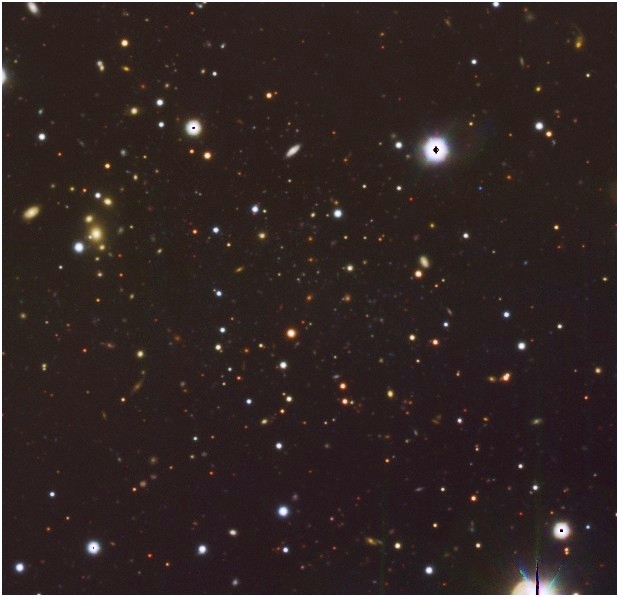







| BOOKS | F. A. Q. | ARTICLES | TALKS | ABOUT KEN | DONATE | BEYOND OUR KEN |
|---|
By Ken Croswell
January 29, 2006

Image by Daniel Zucker, using the Nordic Optical Telescope.
The discovery of a new galaxy orbiting Andromeda gives a
boost to the leading theory of galaxy formation, say astronomers
in Europe and the United States. The new galaxy, named Andromeda
X (pronounced "Andromeda ten"), is the dimmest satellite galaxy
ever seen around Andromeda.
Theorists believe giant galaxies such as Andromeda and the Milky Way--the two largest galaxies in the Local Group--formed when smaller galaxies smashed together. Trouble is, this theory predicts the existence of lots of small galaxies, far more than observers actually see. In particular, the theory says Andromeda and the Milky Way should have hundreds of satellite galaxies.
Now Daniel Zucker of the Max Planck Institute for Astronomy in Heidelberg, Germany, and his colleagues have discovered a satellite of Andromeda that is so faint it suggests many others exist unseen, perhaps resolving the discrepancy. The astronomers spotted the galaxy while examining data from the Sloan Digital Sky Survey. Then they observed the galaxy with two telescopes in the Canary Islands, the 4.2-meter William Herschel Telescope and the 2.5-meter Nordic Optical Telescope.
Andromeda X--the "X" is the Roman numeral ten--is a dwarf spheroidal galaxy, a diffuse collection of stars spread out from one another. Its absolute magnitude is a meager -8.1, making the entire galaxy only slightly more luminous than Deneb in Cygnus (absolute magnitude -7.6) and Rigel in Orion (absolute magnitude -6.8).
In 2004, Zucker and his colleagues reported the discovery of another Andromeda satellite, Andromeda IX, whose absolute magnitude is -8.3. At the time, it was the least luminous galaxy known. However, last year Beth Willman of New York University and her colleagues announced the discovery of the Ursa Major dwarf, a satellite of the Milky Way, with an absolute magnitude of roughly -6.75--the faintest galaxy ever seen.
 But Martin Rees of Cambridge University says these discoveries may not matter so much. "I don't believe there's a severe discrepancy between the current dark matter models and what we observe," he says. Rees thinks the conflict between the predicted and observed numbers of dwarf satellites can be resolved if each known dwarf has more dark matter, and thus more mass, than current observations suggest. "If you associate the observed dwarf galaxies of our Galaxy with 109-solar-mass halos rather than 108-solar-mass halos, then the numbers work out fine," says Rees.
But Martin Rees of Cambridge University says these discoveries may not matter so much. "I don't believe there's a severe discrepancy between the current dark matter models and what we observe," he says. Rees thinks the conflict between the predicted and observed numbers of dwarf satellites can be resolved if each known dwarf has more dark matter, and thus more mass, than current observations suggest. "If you associate the observed dwarf galaxies of our Galaxy with 109-solar-mass halos rather than 108-solar-mass halos, then the numbers work out fine," says Rees.
Astronomers estimate the dark-matter supply in a dwarf galaxy by observing its stars' speeds: the faster the stars move relative to one another, the more dark matter the galaxy must have to hold itself together. But Rees says these observations underestimate a dwarf galaxy's mass, because the stars reside near the galaxy's center, while most of the dark matter is in a halo on the galaxy's outskirts.
Zucker and his colleagues find that the brightest stars in Andromeda X are red giants, aging stars that evolve from stars like the Sun. However, the stars in Andromeda X have only about 1 percent of the solar abundance of iron and other heavy elements.
The red giants' brightness indicates that Andromeda X is slightly closer to us than the Andromeda Galaxy is. Whereas Andromeda's distance from Earth is 2.5 million light-years, Zucker's team estimates Andromeda X is 2.2 to 2.4 million light-years from us. The small galaxy is 280,000 to 450,000 light-years from Andromeda's center. Its angular separation from the center of the Andromeda Galaxy is 5.5 degrees, about the same as the separation between the two "pointer stars" in the Big Dipper's bowl.
Andromeda X is the fifteenth known satellite of the Andromeda Galaxy. Andromeda's brightest satellite, the spiral galaxy M33, emits about 20 percent as much light as the Milky Way. By contrast, Andromeda X gives off only 0.001 percent as much light as the Milky Way. It would take 100,000 galaxies like Andromeda X to equal the radiance of our Galaxy.
In work submitted to Astrophysical Journal Letters, Zucker and his colleagues predict that many other dim galaxies likely orbit Andromeda and the Milky Way: "The discoveries of Andromeda IX and Andromeda X suggest that such extremely faint satellites may be plentiful in the Local Group."
Ken Croswell earned his Ph.D. from Harvard University for studying the Milky Way and is the author of Magnificent Universe as well as a book about the Milky Way, The Alchemy of the Heavens, and another about cosmology, The Universe at Midnight.
"Magnificent Universe by Ken Croswell is elegant and eloquent."--Kathy Sawyer, Washington Post. See all reviews of Magnificent Universe here.
"Ken Croswell's The Alchemy of the Heavens is one of the very best popular astronomy books in decades."--Keay Davidson, San Francisco Examiner. See all reviews of The Alchemy of the Heavens here.
"The Universe at Midnight is vastly entertaining and enjoyable, as well as informative."--Sir Patrick Moore, New Scientist. See all reviews of The Universe at Midnight here.
| BOOKS | F. A. Q. | ARTICLES | TALKS | ABOUT KEN | DONATE | BEYOND OUR KEN |
|---|